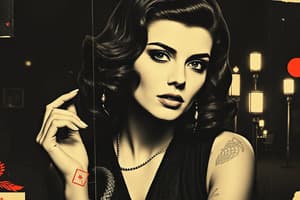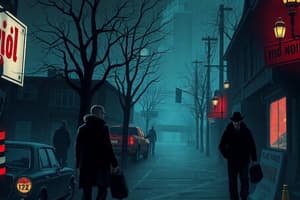Podcast
Questions and Answers
What aspect is NOT a characteristic of film noir?
What aspect is NOT a characteristic of film noir?
- Morally ambiguous characters
- Urban decay themes
- Bright and cheerful colors (correct)
- High-contrast lighting
Which literary genre significantly influenced the narrative style of film noir?
Which literary genre significantly influenced the narrative style of film noir?
- Science Fiction
- Hardboiled Detective Fiction (correct)
- Romantic Fiction
- Historical Fiction
Which of the following films is considered a foundational work of the film noir genre?
Which of the following films is considered a foundational work of the film noir genre?
- Gone with the Wind
- The Maltese Falcon (correct)
- Casablanca
- Citizen Kane
Which event greatly contributed to the themes present in film noir?
Which event greatly contributed to the themes present in film noir?
Which visual technique is commonly associated with film noir's style?
Which visual technique is commonly associated with film noir's style?
Which filmmaker is recognized for their influence on film noir through German Expressionism?
Which filmmaker is recognized for their influence on film noir through German Expressionism?
What societal mood did film noir largely reflect during its classic period?
What societal mood did film noir largely reflect during its classic period?
What term did French critics use to describe American films that showcased a dark visual and narrative style?
What term did French critics use to describe American films that showcased a dark visual and narrative style?
What distinguishes the protagonist in many film noir stories?
What distinguishes the protagonist in many film noir stories?
Which narrative technique is commonly used in noir films?
Which narrative technique is commonly used in noir films?
What role does the femme fatale typically play in film noir?
What role does the femme fatale typically play in film noir?
Which of the following films is NOT considered a classic film noir?
Which of the following films is NOT considered a classic film noir?
What visual technique is commonly used in film noir to create tension?
What visual technique is commonly used in film noir to create tension?
Which factor led to the decline of classic film noir in the 1950s?
Which factor led to the decline of classic film noir in the 1950s?
Neo-noir films often incorporate which additional genre element?
Neo-noir films often incorporate which additional genre element?
What common theme is found in film noir plots?
What common theme is found in film noir plots?
Which of these directors is associated with the neo-noir genre?
Which of these directors is associated with the neo-noir genre?
What does the use of mirrors and reflections typically symbolize in film noir?
What does the use of mirrors and reflections typically symbolize in film noir?
Fatalism in film noir suggests what about the characters’ fates?
Fatalism in film noir suggests what about the characters’ fates?
What hallmark of visual style is typically seen in film noir?
What hallmark of visual style is typically seen in film noir?
Which theme is NOT commonly explored in film noir?
Which theme is NOT commonly explored in film noir?
What is the typical setting for a film noir story?
What is the typical setting for a film noir story?
What role does the femme fatale typically play in film noir?
What role does the femme fatale typically play in film noir?
Which character is NOT typically associated with the hardboiled detective archetype?
Which character is NOT typically associated with the hardboiled detective archetype?
What narrative technique is commonly used in film noir to enhance the complexity of storytelling?
What narrative technique is commonly used in film noir to enhance the complexity of storytelling?
Which of the following best represents the mood of film noir?
Which of the following best represents the mood of film noir?
How does the Hays Code influence the portrayal of crime in film noir?
How does the Hays Code influence the portrayal of crime in film noir?
Which aspect of psychological complexity is often explored in noir protagonists?
Which aspect of psychological complexity is often explored in noir protagonists?
What common theme is frequently depicted through the character of the femme fatale?
What common theme is frequently depicted through the character of the femme fatale?
What does the term 'fatalism' imply in the context of film noir?
What does the term 'fatalism' imply in the context of film noir?
What is a typical characteristic of a crooked cop in film noir?
What is a typical characteristic of a crooked cop in film noir?
How is tension typically created in film noir?
How is tension typically created in film noir?
Which of the following techniques is often employed for voiceover narration in film noir?
Which of the following techniques is often employed for voiceover narration in film noir?
The femme fatale is often portrayed as what in relation to the hardboiled detective?
The femme fatale is often portrayed as what in relation to the hardboiled detective?
Which of the following can be considered a direct result of the Hays Code's influence on film noir?
Which of the following can be considered a direct result of the Hays Code's influence on film noir?
Which of the following themes contributes to the psychological complexity in film noir?
Which of the following themes contributes to the psychological complexity in film noir?
What was a primary strategy filmmakers employed to adhere to the Hays Code's restrictions on explicit content?
What was a primary strategy filmmakers employed to adhere to the Hays Code's restrictions on explicit content?
How did the Hays Code influence characters in film noir regarding moral ambiguity?
How did the Hays Code influence characters in film noir regarding moral ambiguity?
In what way did filmmakers employ creative solutions to navigate the Hays Code's restrictions?
In what way did filmmakers employ creative solutions to navigate the Hays Code's restrictions?
What consequence did the Hays Code impose on femme fatale characters in noir films?
What consequence did the Hays Code impose on femme fatale characters in noir films?
Which film exemplifies the moral punishment of a character as dictated by the Hays Code?
Which film exemplifies the moral punishment of a character as dictated by the Hays Code?
What marked the end of the Hays Code's influence in filmmaking?
What marked the end of the Hays Code's influence in filmmaking?
What is a notable characteristic of neo-noir films compared to classic noir films?
What is a notable characteristic of neo-noir films compared to classic noir films?
What aspect of film noir was often depicted through visual elements such as shadows and reflections?
What aspect of film noir was often depicted through visual elements such as shadows and reflections?
Which example illustrates the implicit sexual tension within the constraints of the Hays Code?
Which example illustrates the implicit sexual tension within the constraints of the Hays Code?
What societal change led to the decline of the Hays Code?
What societal change led to the decline of the Hays Code?
Flashcards are hidden until you start studying
Study Notes
Origins and Influences of Film Noir
- Emerged in the early 1940s in Hollywood, characterized by dark atmosphere and morally ambiguous characters.
- French critics coined the term "film noir," translating to "black film" or "dark film" in the late 1940s.
- Influenced by German Expressionism, which introduced stylized lighting and psychological unease.
- Hardboiled detective fiction from writers like Dashiell Hammett and Raymond Chandler provided gritty narratives.
- Economic hardship during the Great Depression and trauma from World War II reflected a sense of disillusionment mirrored in noir themes.
- French Poetic Realism emphasized doomed characters and fatalistic themes, influencing noir's tone.
Classic Noir Period (1940s - 1950s)
- Known as the "classic" film noir period, with foundational films like The Maltese Falcon (1941) and Double Indemnity (1944).
- The Maltese Falcon introduced the classic noir detective; Double Indemnity established the femme fatale trope.
- Key characteristics include low-key lighting for danger and claustrophobia, non-linear narratives, and themes of existential angst, alienation, and identity.
- Prominent films: Laura (1944), The Big Sleep (1946), Kiss Me Deadly (1955).
End of the Classic Period
- The classic noir period declined in the mid-1950s due to several factors.
- The rise of color film diminished the black-and-white aesthetic of noir.
- McCarthyism and the Red Scare led to blacklisting in Hollywood, stifling creative expression.
- Television's popularity diverted audiences from cinemas, reducing demand for darker genres.
Neo-Noir (1960s - Present)
- Neo-noir emerged as a modern update of classic noir, revisiting its themes with contemporary relevance.
- 1960s-70s resurgence included directors like Polanski (Chinatown, 1974) and Altman (The Long Goodbye, 1973).
- Notable neo-noir films blend classic elements with new issues, such as political corruption.
- 1980s-90s expansion by filmmakers like the Coen Brothers (Blood Simple, 1984) and Ridley Scott (Blade Runner, 1982), introducing "tech-noir."
- 21st-century neo-noir continues with directors like Christopher Nolan (Memento, 2000) and David Fincher (Se7en, 1995).
Legacy and Influence
- Film noir significantly impacted cinema, inspiring crime thrillers and cinema techniques worldwide.
- Established character archetypes like the antihero and the femme fatale, alongside defining visual styles.
Key Traits of Film Noir
Visual Style
- Chiaroscuro lighting creates mystery, danger, and moral ambiguity.
- Urban settings evoke alienation through rain-soaked streets and dark alleyways.
- Oblique angles and reflections symbolize deception and fractured identities.
Themes
- Moral ambiguity presents characters as flawed and often antiheroes.
- Fatalism portrays characters trapped by fate and circumstances, leading to bleak outcomes.
- Common themes include betrayal, deception, crime, and existential angst.
Character Archetypes
- Antiheroes are flawed individuals navigating morally gray situations.
- Femme fatale as a manipulative, seductive figure leading protagonists to ruin.
- Hardboiled detectives exemplify cynicism and isolation, often operating in gray moral areas.
Plot and Narrative Techniques
- Crime and investigation central to the narrative, revealing societal corruption.
- Use of flashbacks and nonlinear storytelling emphasizes character complexity.
- Voiceover narration conveys inner turmoil and reflects existential themes.
- Twists create suspense and tragic revelations rooted in betrayal and deception.
Psychological Complexity
- Protagonists experience guilt, paranoia, and mental unraveling.
- Explores dynamics between sexuality and power, often charged with tension.
- Identity themes reveal characters living double lives or grappling with true selves.
Atmosphere
- Dark, gritty mood permeates through visuals, setting, and storytelling.
- Claustrophobia and isolation evoke characters' entrapment in their circumstances.
- Tension builds through suspenseful interplay of shadow and light.
Fatalism
- Characters’ doomed destinies underscore the inevitability of their tragic choices.
- Dark endings reinforce themes of moral failing and external pressures.
Impact of the Hays Code on Film Noir
- The Hays Code imposed restrictions on violence and crime, necessitating moral consequences for wrongdoers.
- Characters often must face punishment for their actions, reinforcing the genre's fatalistic tone.
- The femme fatale typically meets a tragic end as a result of her immoral behavior to fulfill the Code's requirements.
- Filmmakers utilized symbolism and implicit storytelling to navigate the constraints, using visual and narrative methods to convey themes of moral complexity.
The End of the Hays Code
- The Hays Code began to decline in the late 1950s, leading to the rise of neo-noir.
- New rating systems enabled more explicit content, fostering complex and morally ambiguous narratives, as seen in films like Chinatown (1974) and L.A. Confidential (1997).
Studying That Suits You
Use AI to generate personalized quizzes and flashcards to suit your learning preferences.




